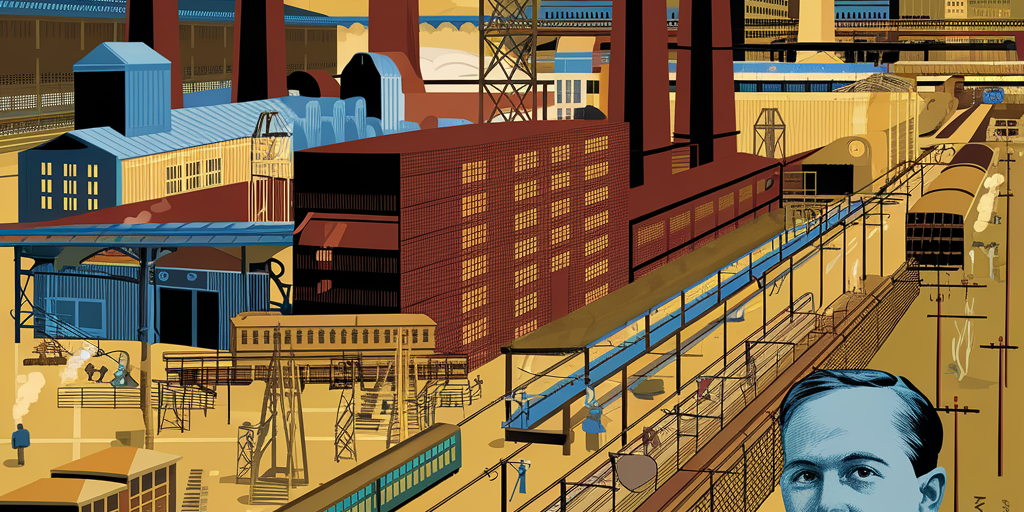Introduction: The Birthplace of Modern Power
When Pittsburgh’s industrial titans are named, Carnegie and Mellon often dominate the conversation. But another name — George Westinghouse — arguably changed the world just as profoundly. His innovations in electric power, rail safety, and industrial technology not only shaped Pittsburgh but revolutionized modern life globally.
This is the story of how Westinghouse’s empire grew from Pittsburgh, transforming the city into the cradle of American electricity, transportation, and nuclear power — a legacy that still echoes today.
George Westinghouse: The Relentless Inventor
Born in 1846 in New York, George Westinghouse was an engineer and inventor from the start. By age 22, he revolutionized the railroad industry with his invention of the air brake (1869) — vastly improving safety and efficiency.
Why Pittsburgh?
- Westinghouse recognized Pittsburgh’s strength in manufacturing, labor, and transportation.
- He chose Pittsburgh as his base, founding Westinghouse Air Brake Company (WABCO) in Wilmerding, PA, and later multiple companies bearing his name.
Building an Industrial Empire in Pittsburgh
Between 1870 and 1900, George Westinghouse founded over a dozen companies — many headquartered in Pittsburgh — including:
1. Westinghouse Electric Company (1886)
- Pioneered the use of alternating current (AC) power.
- Became the chief rival of Thomas Edison’s direct current (DC) systems.
2. Westinghouse Air Brake (1869)
- Revolutionized railroad safety globally.
- Helped Pittsburgh dominate the rail equipment industry.
3. Westinghouse Machine Company
- Developed steam turbines and engines powering industries.
Westinghouse’s companies employed tens of thousands across Pittsburgh and Western Pennsylvania, turning towns like East Pittsburgh, Trafford, and Wilmerding into industrial powerhouses.
The War of Currents: Pittsburgh vs. Edison
Perhaps Westinghouse’s most famous battle was his showdown with Thomas Edison in the War of Currents:
- Edison pushed DC power, which was inefficient over long distances.
- Westinghouse backed Nikola Tesla’s AC power, capable of powering entire cities.
The Turning Point:
- 1893 World’s Columbian Exposition (Chicago): Westinghouse electrified the fair with AC.
- Niagara Falls Power Project (1896): Westinghouse harnessed the falls to power Buffalo — a massive PR and technological victory.
AC power won, and Pittsburgh became the heart of America’s electric revolution.
Nuclear Power and Mid-20th Century Expansion
Westinghouse didn’t stop with electricity and railroads:
Key Achievements:
- Developed the first U.S. commercial nuclear power plant at Shippingport, PA in 1957.
- Became a global leader in nuclear reactor technology.
- Expanded into household appliances, broadcasting (KDKA Radio), and defense.
At its peak, Westinghouse Electric was one of the largest companies in the world, employing over 50,000 people in the Pittsburgh region.
Impact on Pittsburgh’s Communities and Workforce
Westinghouse shaped not just industries but communities:
- Wilmerding and East Pittsburgh were “Westinghouse towns,” built around factories.
- Generations of Pittsburghers found stable, middle-class careers through Westinghouse.
- Funded schools, libraries, and public amenities across the city.
Westinghouse helped create Pittsburgh’s reputation as a center for engineering and innovation — a legacy still seen in the region’s tech and robotics sectors.
Challenges, Breakups, and Reinvention
The late 20th century brought challenges:
- Global competition and shifts in energy markets strained the company.
- 1980s-90s restructuring led to the sell-off of divisions and the end of Westinghouse as an industrial conglomerate.
Yet, Westinghouse reinvented itself:
- Today, Westinghouse Electric Company remains a global leader in nuclear energy, still headquartered near Pittsburgh.
- The Westinghouse name lives on in energy, appliances, and historical sites.
The Lasting Legacy: Powering the World from Pittsburgh
Few companies have shaped the modern world — and Pittsburgh — like Westinghouse:
- Made AC power the standard, electrifying the world.
- Transformed railroads, factories, and homes.
- Helped birth nuclear energy.
Today, Westinghouse’s impact is still visible in Pittsburgh’s landscape, economy, and spirit of innovation.
Famous Westinghouse Landmarks:
- The George Westinghouse Memorial in Schenley Park.
- Wilmerding’s Westinghouse Castle (Air Brake HQ).
- East Pittsburgh’s former massive electric works campus.
Conclusion: Pittsburgh’s Global Powerhouse
George Westinghouse’s vision turned Pittsburgh into a global center of energy, innovation, and industrial might. His legacy lives on in the power grids, railways, and reactors that shape our world today — a true testament to Pittsburgh’s role in powering modern life.









